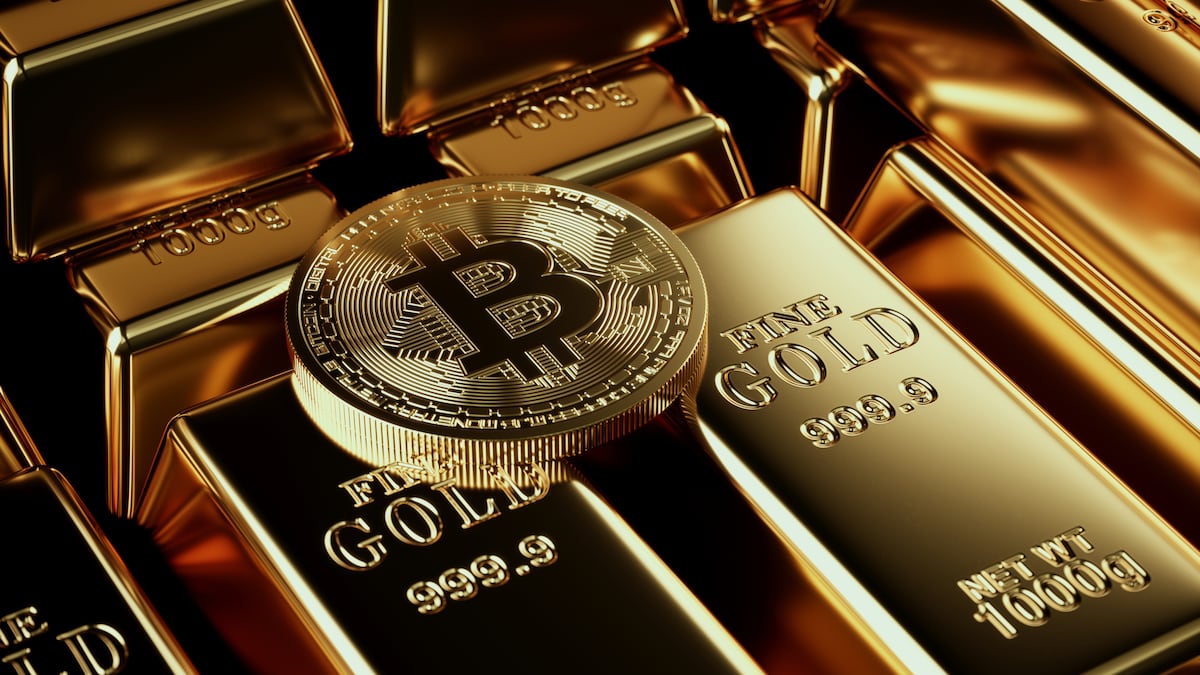- Gold hit a record high in August, reaching above $2,500 per ounce.
- But Bitcoin is still 20% from it's all-time high.
- Here's what's driving the two assets, according to analysts.
Gold has been hovering near record highs, driven by factors like inflation, geopolitical turmoil, and central bank purchases.
Whatever the reasons, “they nearly all come back to the fact that gold is a stable investment,” Rick Kanda, managing director at the Gold Bullion Company, said in an emailed note to clients.
Proponents of Bitcoin, including BlackRock CEO Larry Fink, tout the cryptocurrency as digital gold.
While gold reached a record in late August, climbing above $2,500 per ounce, the largest cryptocurrency is still 20% off from its highs.
So, what gives?
Bitcoin has had other issues to contend with, including large sell-offs from Germany and creditors of collapsed crypto firms, says analyst Noelle Acheson.
It’s also more sensitive to US political uncertainty, she said.
Below are six factors driving gold — and what it means for Bitcoin.
Economic uncertainty
Gold’s status as a haven asset means demand typically rises during economic crises and recessions. The devaluation of major currencies as a result has also shored up gold demand.
Normally, Bitcoin would fall into the same boat.
The dollar, measured by the DXY dollar index, is near one-year lows. Historically, Bitcoin has moved in the opposite direction of DXY, said Acheson.
For now, though, Bitcoin’s price action is more closely tethered to political sentiment.
Inflation
The Federal Reserve and other central banks are trying to tackle a surge in global inflation.
“During an inflationary period for the economy, investors often opt for gold over cash due to its stability,” the Gold Bullion Company said.
“This is because any devaluation of currencies resulting from inflation will increase the price of gold in that currency, thus preserving the buying power of the investment.”
Bitcoin, despite analysts touting it as an inflation hedge, performed poorly during a period when inflation has been at its highest.
As inflation in the US rose to a 30-year high of 9.1% from January to June 2022, Bitcoin plummeted 31% over the same period.
It was also at this time that the 15-year-old asset reeled from the dramatic collapse of the crypto exchange FTX.
This suggests that, unlike gold, Bitcoin is subject to acute inter-industry chaos.
Diversification
The best investors tend to diversify their portfolios to protect against sharp declines in any one asset.
Gold is viewed as a hedge against economic and political uncertainty, while other asset classes can fluctuate. Geopolitical risks, including the conflicts in Gaza and Ukraine, have helped drive gold prices.
“Gold also offers a type of investment insurance,” the gold firm said. “Following 2022′s crypto crash, there was an increase in investors moving from digital assets like Bitcoin to physical assets like gold.”
Countering Bitcoin’s digital gold narrative, Bitcoin has more closely tracked riskier assets, including the tech-heavy Nasdaq index.
Thus, Bitcoin demand is likely to fall as investors’ risk appetite wanes during times of uncertainty.
“Bitcoin is clearly not an inflation hedge, and is a risk-on asset that tracks global liquidity,” Ashwath Balakrishnan, lead at crypto consultancy Delphi Creative, told DL News.
Global liquidity refers to how much money is flowing around in the market.
Are the "BTC is an inflation hedge" people still around?
— Ashwath (@ashwathbk) September 2, 2024
Central bank buying
Central banks have been piling into gold, with China, Turkey, and India leading the way at the start of the year.
“Gold’s performance in crises and its role as a long-term store of value are key reasons for central banks buying gold,” the gold firm said.
The same can’t be said for Bitcoin, according to at least one central bank.
The official X account for the European Central Bank wrote in January that the ECB is very unlikely to ever buy Bitcoin during an ask-me-anything event.
Production
“Gold mining production has remained similar since 2016,” the Gold Bullion Company said.
Stagnant production means miners need to dig deeper to access more gold reserves.
Scarcity — driven by risk, costs, and time to mine more gold — adds to gold’s value.
Bitcoin miners — the colloquial term for the computers that use enormous amounts of energy to create more Bitcoin — are also getting squeezed.
In April, the network experienced a halving event, where the amount of Bitcoin created by miners was cut in half.
Liam Kelly is a DeFi correspondent at DL News. Reach out at liam@dlnews.com.
